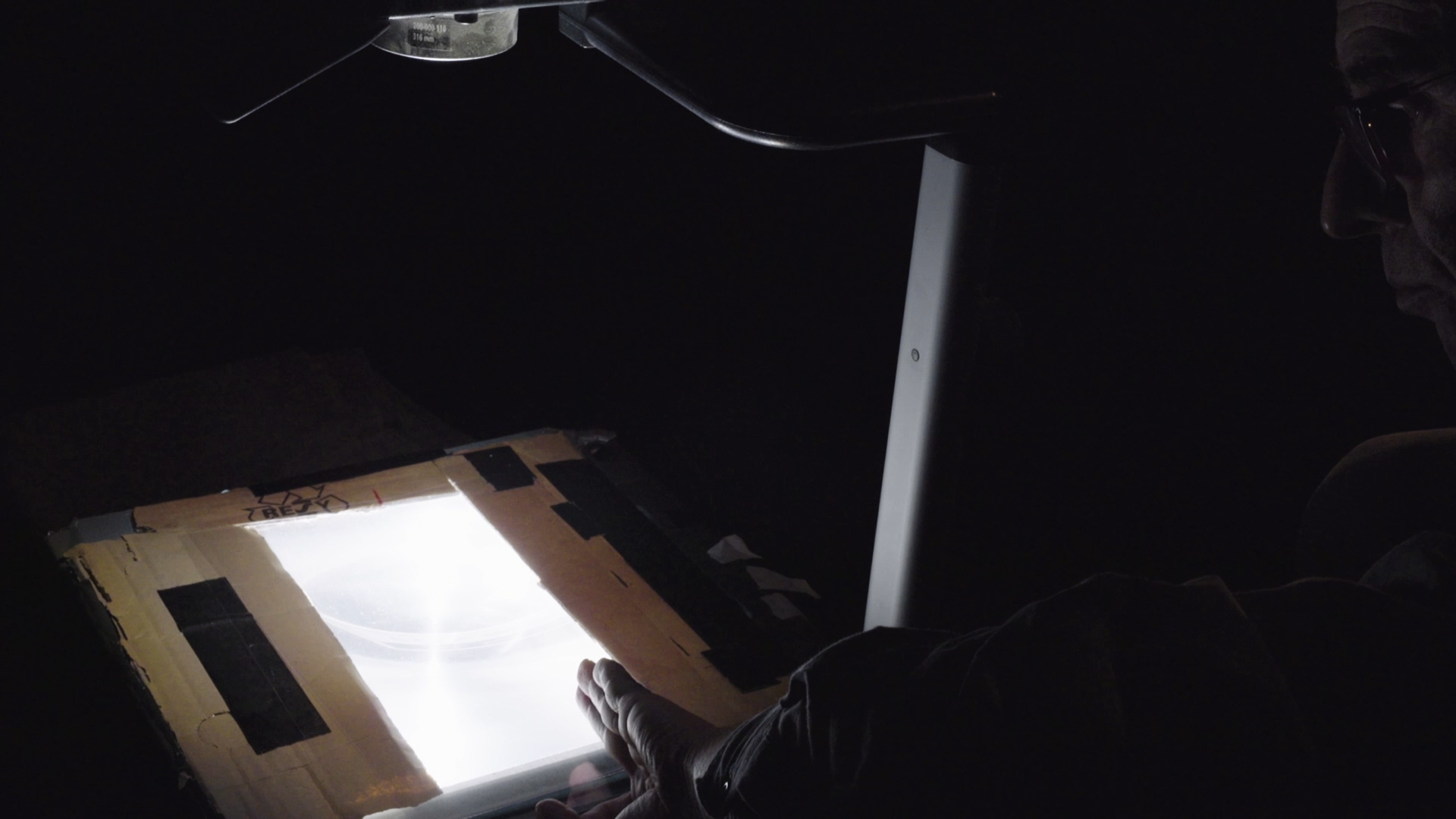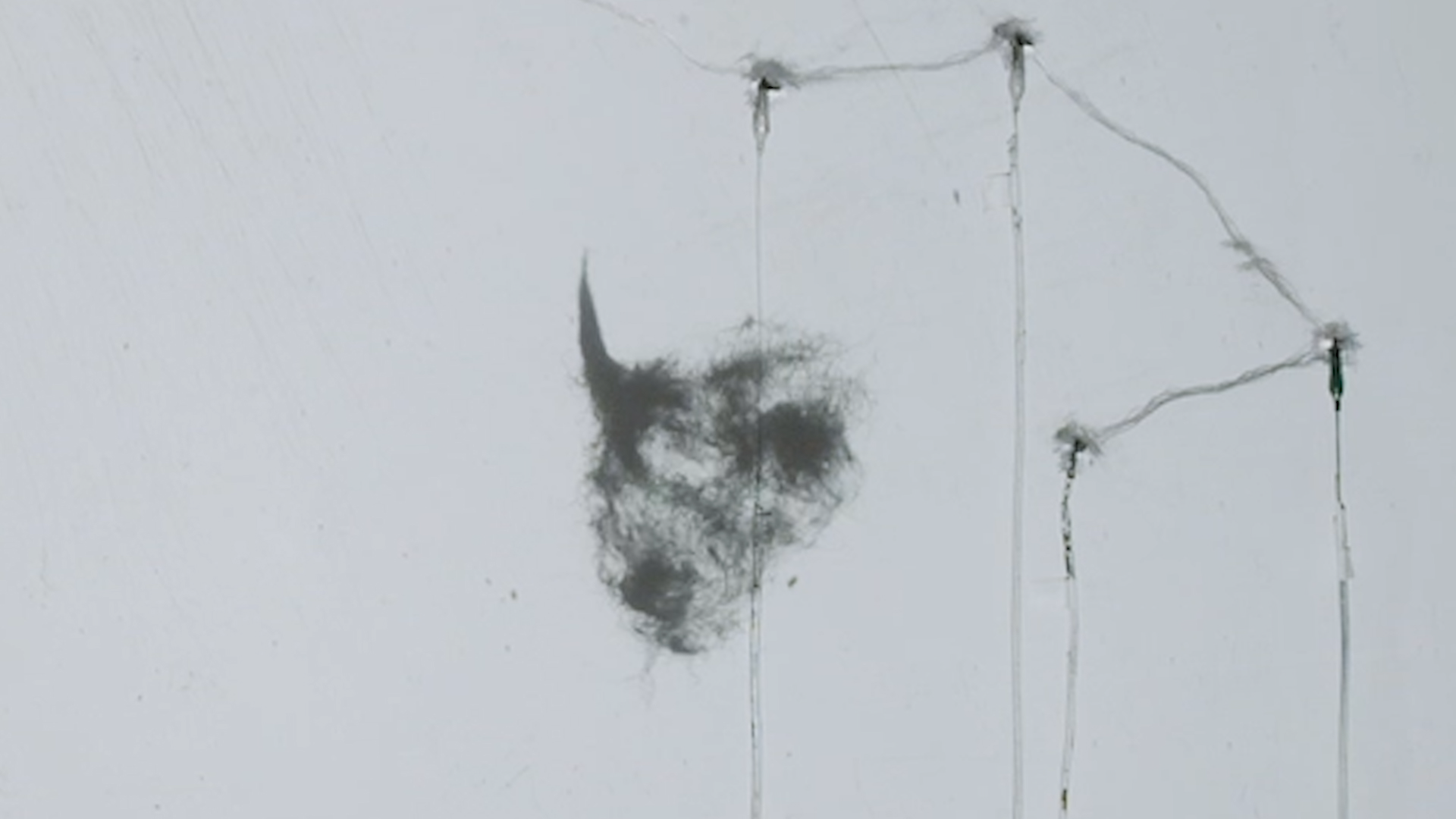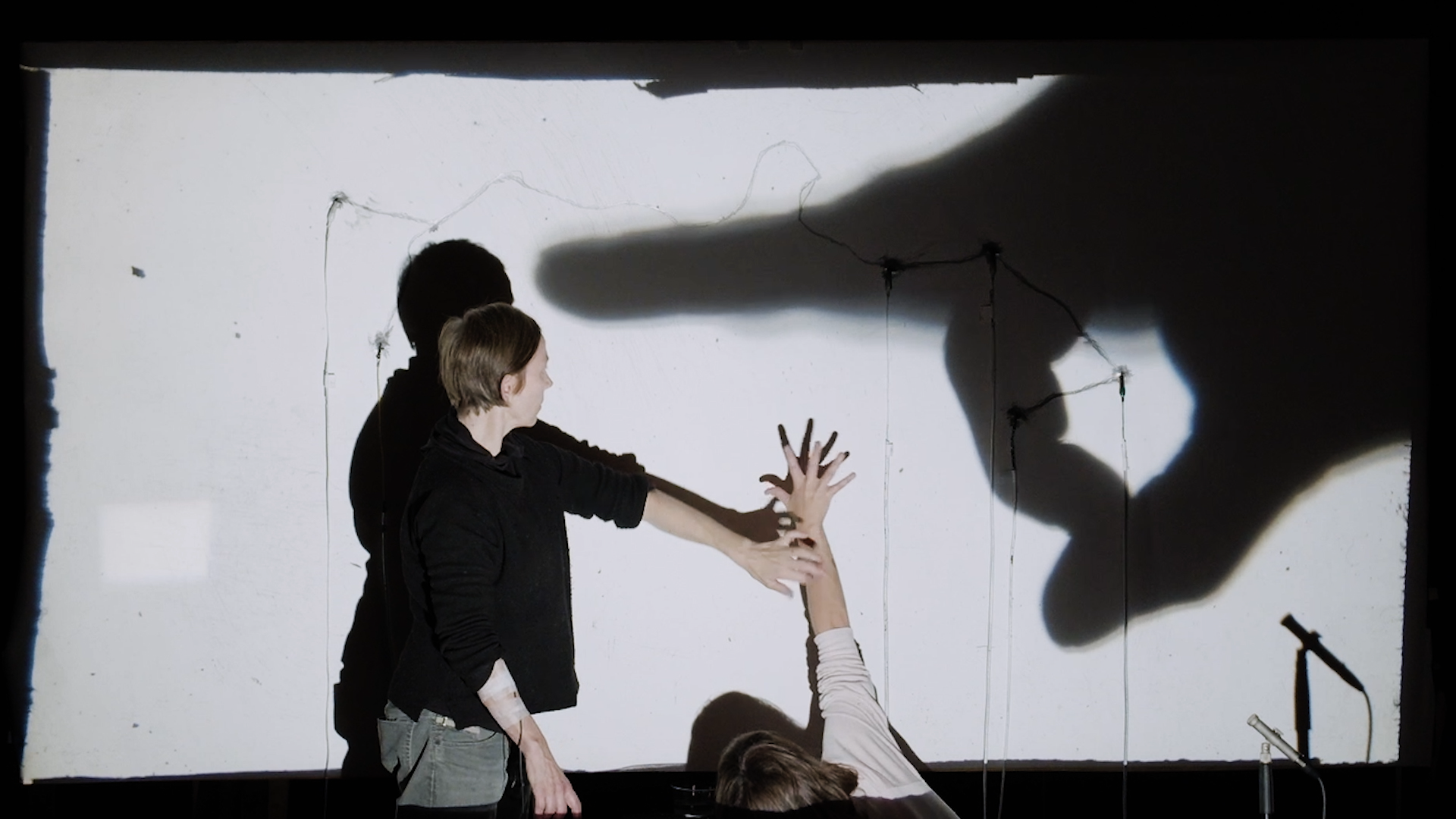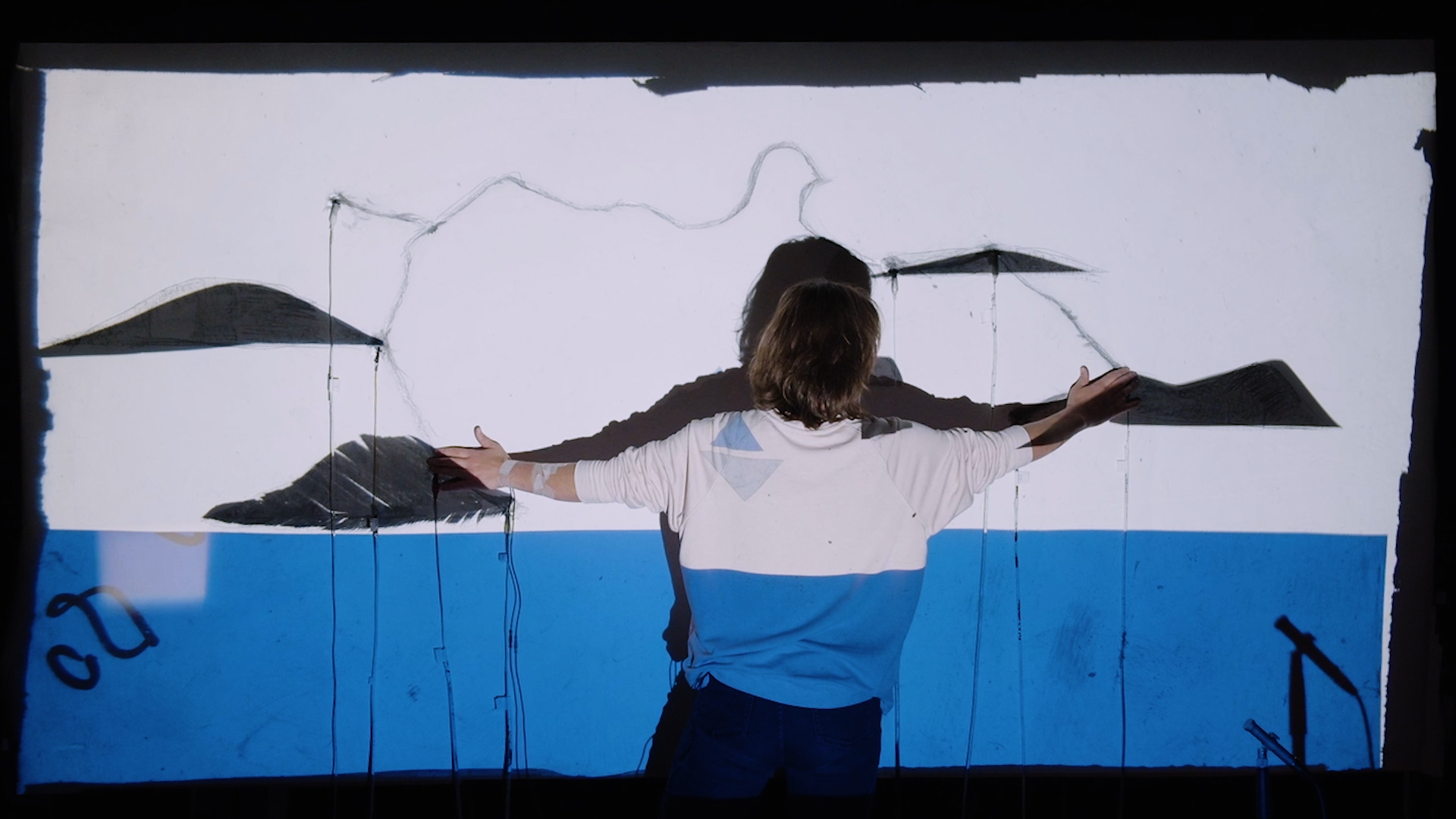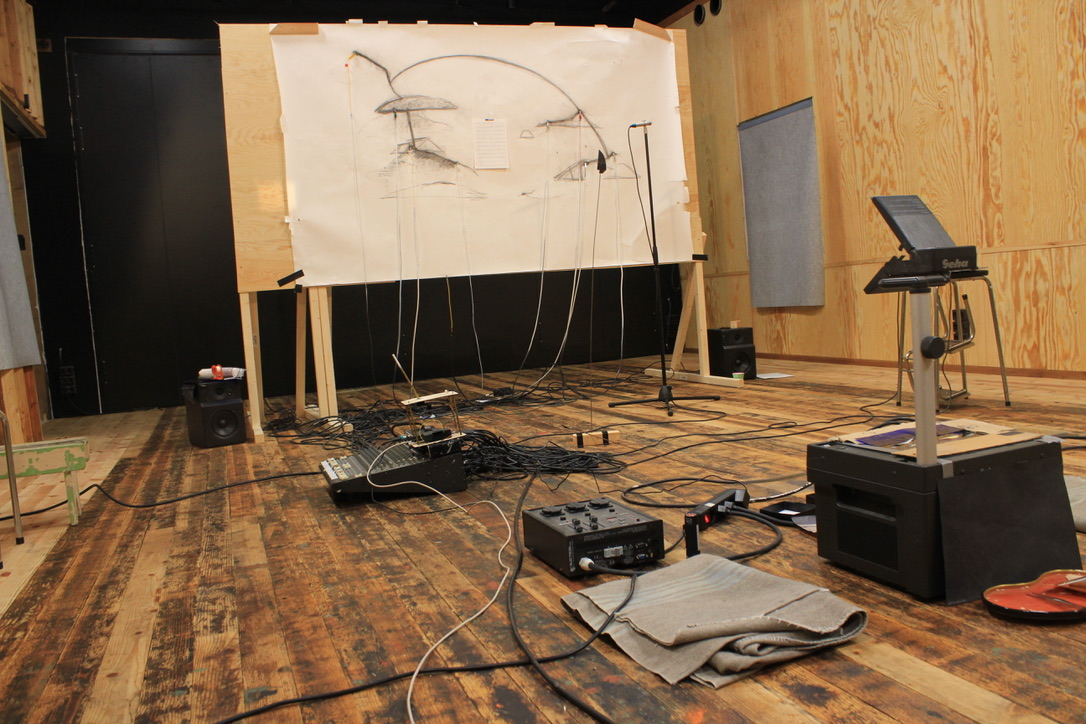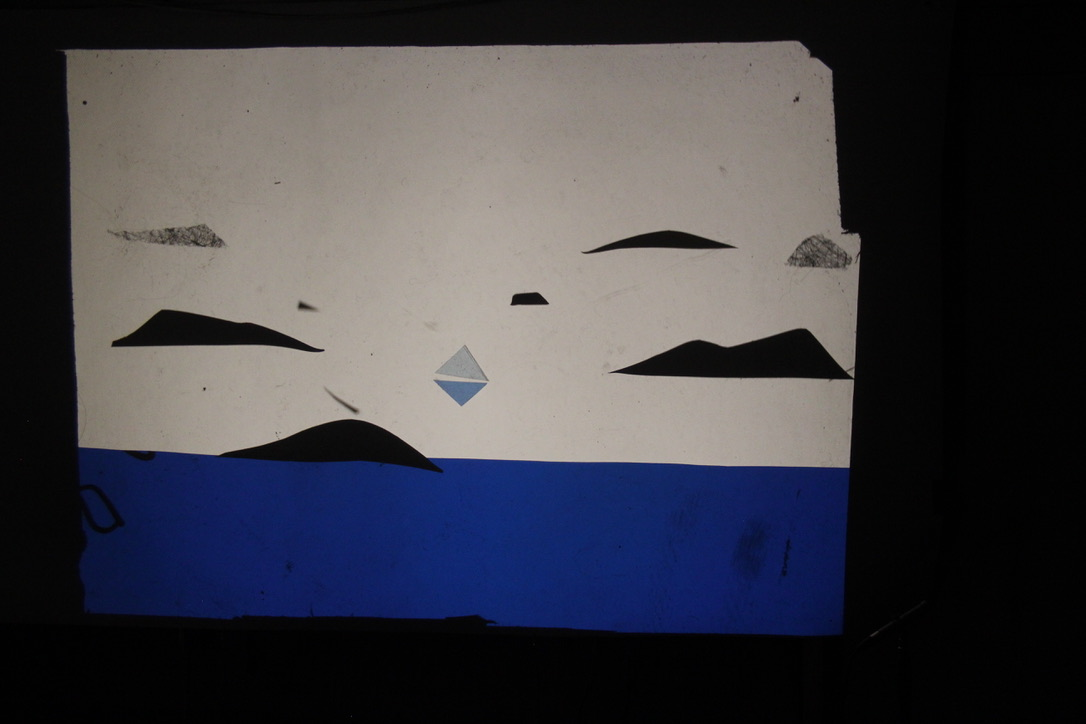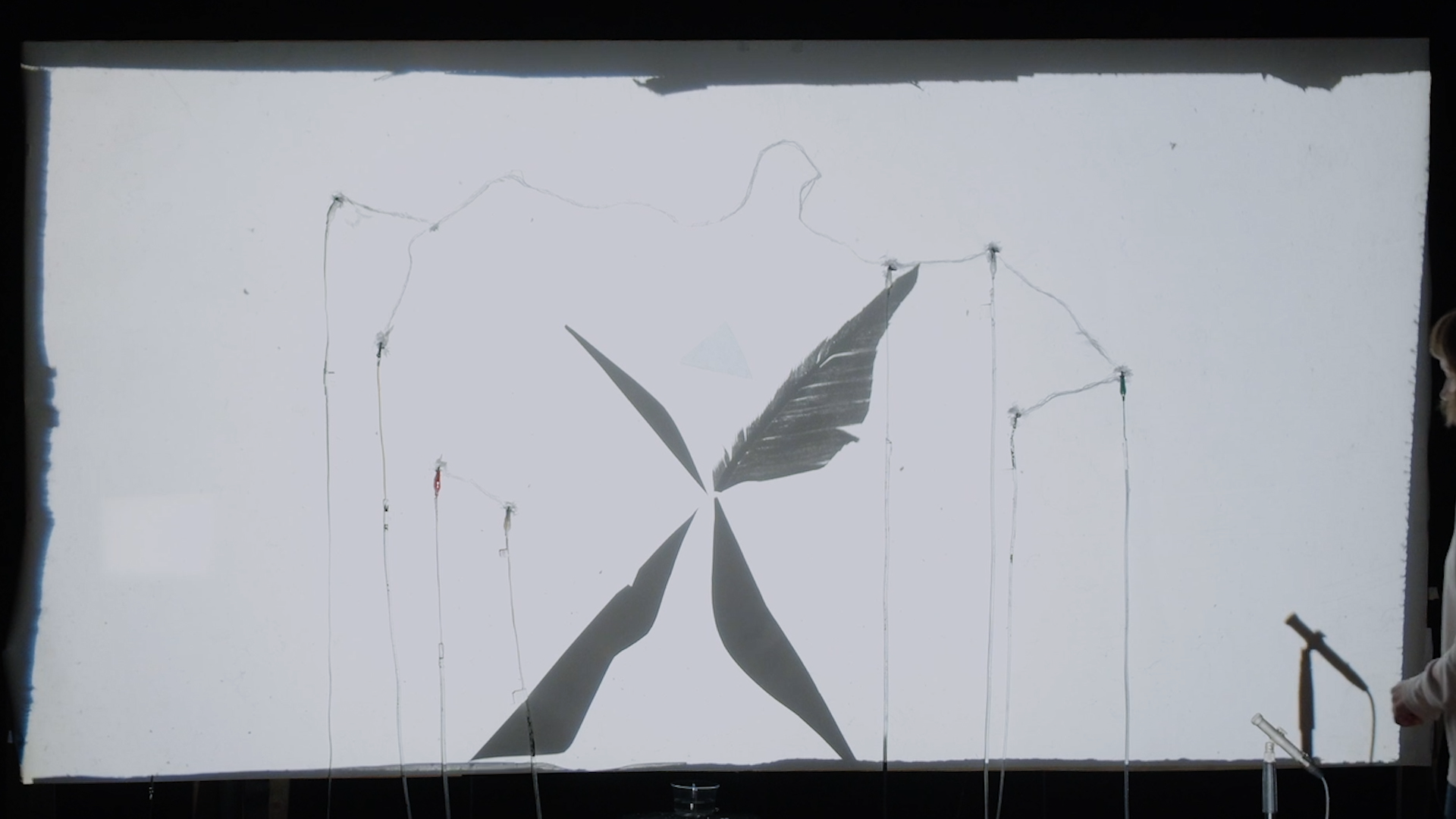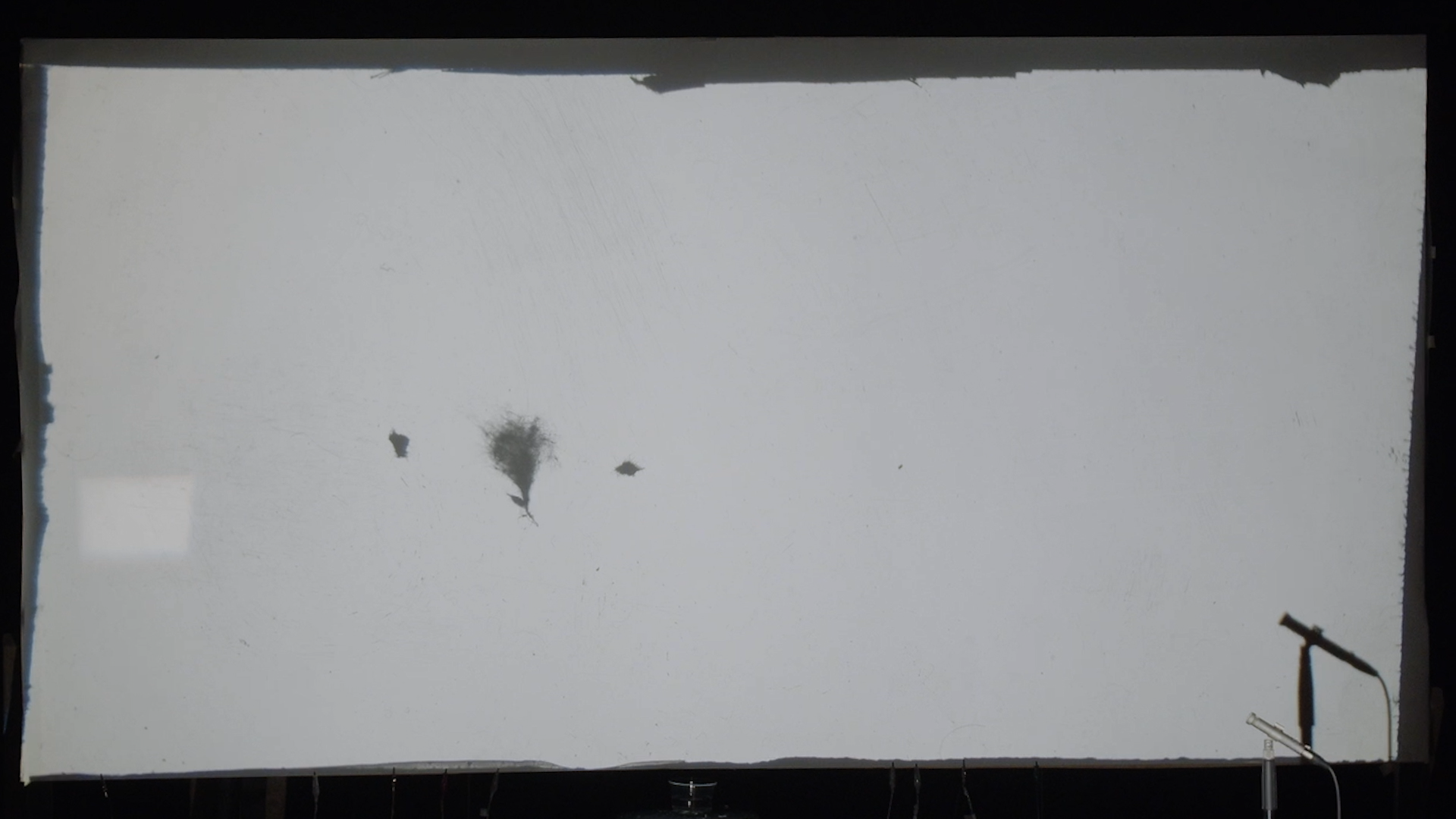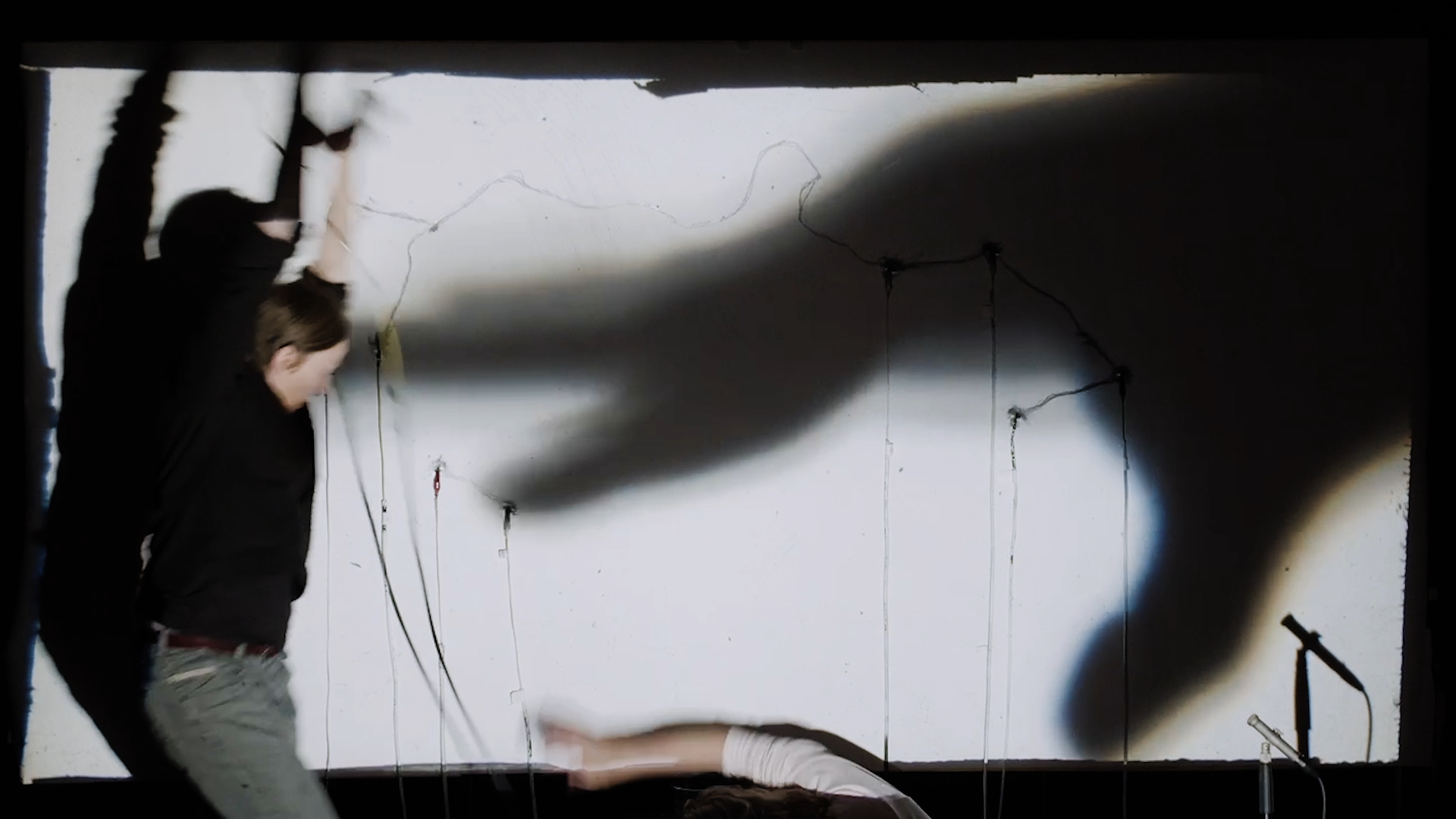I think of Bly in terms of two compositions. One is the staged area with the things in it, this is composed during the process of making BLY, prior to a performance. The second composition is the time-based dramaturgy of actions, sounds, lights, things, all the elements that are put into play throughout the piece. This text discusses that which I kept particularly in mind whilst selecting the elements and working out the form for Bly. I wanted to have a collection of eclectic elements that do not connect immediately, and I wanted to compose with them in a fairly tight form, repeating and varying the dramaturgy and the different applications of the elements.
The staged area
The work area on the overhead is the glass on top, where the light shines through. A determining factor for the stage-area in the room, as a whole, is the relation between the work area on the overhead and the distance to the back wall. The further back we move the back wall, the bigger the lit area on it becomes. I wanted the back wall as big as possible, yet small enough for Ali to make a drawing and for Ellen to be able to reach close to its outer edges whilst playing. On the other hand, the work area on the overhead needed to be big enough for Cecilie and Ali to be able to handle the things they would lay on it. A pragmatic solution was to crop the work area as small as it could be and move the wall back as far as we could. This maintains both the need for a big enough work area and gaining a lit back wall for drawing and playing. The result of all these limitations is a stage area of approximately 5 x 5 meters, it is quite small. The back-wall needed to be an instrument for a single person, this dictated the size. Ali and Ellen needed to be able to reach close to its outer edges. An aesthetic biproduct of these considerations were the torn edges on the cardboard that we used to crop the work area with, this was co-incidental and became a significant part of the overall expression. My way of working, in trying things quickly, with whatever I have at hand, cardboard, sometimes yields this kind of result. The jagged shade of the torn cardboard became a part of the aesthetic signature of BLY. And the resulting stage area turned BLY into a chamber play.
In this space we are working with average size bodies, small things and magnification. The performing body handling small things lends BLY a touch of intimacy, the bigger body carefully treating small things, laying them out, handling with care, with attention to detail. This is further enhanced when the performers sit on their knees, crouching to get close enough. In an early phase, Ellen and I tried sitting on stools with the overhead on a small table, we opted for the floor because of what we read into the combination of crouching and handling small things. In our eyes it has a connection to doing something out of necessity due to the inconvenience involved, it lends importance to the tasks.
Magnfication
A central part in BLY is magnification, and when something is magnified it is also transformed. Magnification shows us how fundamental proportions are to our understanding of our surroundings. The shift in size shows us a different set of qualities, a small movement becomes large, the minute detail is revealed, and a spectator is given insight. We need magnification to allow us to see the rich textures present inside a piece of lint
Magnification can also be humorous. Ali´s hand when flicking Cecilie of the stage is both threatening and funny, perhaps also a comic relief from the otherwise concentrated wondering situation. Enlarging Ali´s hand also shrinks Cecilie and Ellen, they shrink and transform from humans on a stage to two creatures of imagination, only 3 cm tall.
Cecilie on magnification:
Performing actions and movements in BLY happened at the same time in completely different perspectives and sizes. Blowing a small piece of lint in tiny movements over an overhead surface, is movement on a micro level. At the same time on the projected surface in the light, the size of the movements is magnified. BLY required listening to what is enough, to silence and permanence. I was challenged and used the qualities I have as a dancer and performer. Any movement set out in a room frames the silence, sets an approach. I usually work with precision, but it was challenging to work with precision with small objects, it easily went wrong, and the shift in perspective, magnification, made the mistakes bigger.
What are the things and why are they chosen?
The choice of physical materials such as lint, an overhead, papercuts and a pop filter made from “things you find in a drawer” is meant to give the work a low level of entry. I lean on traditions of arte povera and punk-rock for their iconoclasm in shifting the ordinary into the high seat, BLY also bears the stamp of Art Brut in the sense that the artists involved are invited into this field where none of their expertise is completely at home. I try to place the work in a sort of low budget, simple means type aesthetic, hoping the audience will have prior tactile knowledge of some of the things involved. This is to set the stage for a “what you see is what you get” expectation and then start to explore the materials at hand revealing unexpected connections and qualities. I attempt to connect to the playful and childish where stories and connections rise from a spectator´s ability to transform an unsignificant piece of scrap into an island, a cloud or a leg. The vessel for the composer is to manipulate the constellations, the necessary participation on the spectators side is imagination.
To facilitate this, I try and keep the latent expectation in the room open, as opposed to a stage with a self-fulfilling prophecy such as a drumkit. Yes, there is a mixer, a microphone, lights, and speakers on stage. These are elements that I quite simply accept as stage furniture, apart from these I try and keep the things on stage unassuming. The overhead is a bit risky, it is my hope that it seizes to be a classroom antique through our use of it, and that it becomes a magnifying glass focusing the play that takes place on it.
The simplicity in the object´s visual appearances and the color palette apparent in Bly is chosen to achieve a homogenous collecting effect, to appear as belonging together due to similarity. This is a way of orchestrating in extended composition.
The back wall is a contrast when the overhead light is above 80%. Then it turns into another place, and we facilitate a travel into the screen with the crisp blue and the sharp outlines.
I will claim that some things lend themselves to certain configurations more easily than others, and that this is related to the thing´s quality. A bone will more easily become a leg than an orange would. Another consideration is the things degree of abstraction, by this I mean its lack of connections to something known to us. If the associations arise easily, they can work as a smokescreen whilst we transform the thing by way of placing it in a surprising configuration; the ahhh, now I see. A fairly abstract element, something without strong associations, is a very versatile building block. A looped and whistled tone is an example from BLY. When recorded and looped it stretches beyond the limitations of breath and detaches from the whistling body. Its timbre is bright and sparse, close to a sine wave oscillator to our ears. Ellen and I started out with sine waves for the purpose and then developed into whistling and looping. In my ears the sonic quality points to early electronic music, still we know it originates from a body. In terms of timbre, I feel that it carries the tension between body and technology in its sonic identity. In terms of being a building block, it is a simple element, a single pitch without too much of associations connected to its timbre, it would fit in many musics.
Objects that are compounds to our senses are more difficult, they are situations with a perceivable interplay. I am looking to create constellations and compose the interplay in them; therefore I need simple singular objects without too much friction in terms of sticking out, pointing to something else or being in itself a perceivable situation. For this reason, I use papercuts and lint, things made for the occasion. What I want is to achieve a self-referring strong composition with tight relations between the elements.
An aesthetic ideal in my work is for a thing to be good despite it´s apparent abilities. This is also an ethical ideal. I look for the qualities in the thing itself without testing it against an established set of criteria such as fast, big, or shiny. I am not saying that everything has to be small, slow and dirty. I mean that in the right constellation a thing can appear just in place and display a surprising quality. That is what I am looking for, and I choose this to accentuate the quality in the composition rather than the things in it.
Variation form is a very basic technique in musical composition. One might have a melody and accompaniment in a major key, and then vary it by playing slower in the parallel minor key, and then again with extra ornaments and so on. In Bly, principles of variation are present in two ways. It is in the dramaturgy, how the scenes are repeated with variation. Almost every scene has two appearances, distributed in the second or the first half. The blowing on lint sets of both halves. Another way that variation form is seen is by way of utilizing many of the elements in different constellations, making them elements in different compositions. In the same manner as the pitch C is the tonic in a C chord and the low third in the a-minor chord, the cut feather is an arm on Kandinsky and an Island in the coastal landscape. By way of configuration and imagination, things can transform and become other things.
What are the CONSTELLATIONS and what happens in them?
The variation on a thing in a constellation and the variation on the dramaturgy are mutually strengthening. Showing the play with lint twice, underlines the importance of lint, having it before and after other parts cast a connection in memory back to the start of the piece upon its return. Every time a connection between things is varied upon, and every time scenes in the dramaturgy are varied upon, the composition, the mesh of connections in a piece, is strengthened and it approaches unity.
My understanding is that somewhat abstract composition is closely connected to Pareidolia. In the opening scene, when Cecilie has dropped the third piece of lint, we have the basis for a face; three points of anything on a background. This coala appeared at one point whilst we were filming.
Then there is the balance between the sentripetal and sentrifugal powers that tug at a composition. Sentripetal powers are those that pull things together. Similarity, proximity and association are primary ones. These ideas are derived from reading The Order of Things (Foucault 1966), where he demonstrates how knowledge in the 16th century is lagrely based on resemblance:
It was resemblance that largely guided exegesis and the interpretation of texts; it was resemblance that organized the play of symbols, made possible knowledge of things visible and invisible, and controlled the art of representing them.
Humans have since split the atom and parted with our sensory system as any kind of barrier for knowledge. But in experiencing art, our sensory system is very much put into play.
Pareidolia is the tendency for perception to impose a meaningful interpretation on a nebulous stimulus, usually visual, so that one sees an object, pattern, or meaning where there is none.
Common examples are perceived images of animals, faces, or objects in cloud formations, seeing faces in inanimate objects, or lunar pareidolia like the Man in the Moon or the Moon rabbit. The concept of pareidolia may extend to include hidden messages in recorded music played in reverse or at higher- or lower-than-normal speeds, and hearing voices (mainly indistinct) or music in random noise…
https://en.wikipedia.org/wiki/Pareidolia
Therefore similarity, proximity and association are important for me to keep in mind when considering the balance in a form.
Proximity is at work when different objects are placed closely together, and there is a lack of disturbing connections around. Place a feather and a piece of grass on a white table together, and suddenly the relation between the feather and the Grass is activated, we start imagining connections. If, on the other hand, you find a piece of grass on the floor of your living room and a feather in your windowsill, these objects are not connected, they are not in proximity of one another and there are very many other possible connections.
When we understand the power of proximity, we understand that there are no actual connections between sounds other than those that our perception imposes upon them. The premises for our perception to make these connections are proximity, similarity and fairly uncluttered surroundings. An illustration is two notes played simultaneously. They are so close that we sometimes describe them as one thing, an interval of a certain quality. If played seconds apart they can be perceived as the start of a melody. If moved apart by 20 minutes and a stroll through the city, there is no connection. For a listener to listen music, tones need to be in close proximity.
Similarly with similarity. Two pitches produced on similar qualities in terms of timbre are grouped. A rather eclectic element, such as Varese introducing sirens into an orchestra, they stand out and stretch the association upon which the entire composition depends. This stretch is orchestration, sentrifugal orchestration.
Association places an element and its constellation in a larger context and this is highly individual. Still, in a culture we have probable common associations that we can identify and place our works within. In the case of BLY, I aim for ordinary things of low value, pieces of paper and lint, to be transformed and lifted, by way of composition.
Sentrifugal powers are those that pull at a work as a delimited entity. Big differences between the elements and lack of proximity in time and space makes for a fragile composition. If a piece of music has more than 30 seconds between each sound, I would conclude that the music has collapsed. The grouping of elements need to be connected quite closely, also in terms of space, we would rather have things collected in the same area, say a stage, then these things are clearly a part of the piece. Other places in the room are frequently used, amongst the audience or hanging from the ceiling in the back, yet this is always then noticed as extraordinary. Off stage sound has proven effective, and is used to illustrate distance, providing a clear and intentional use of proximity, filtering the sound through walls gives the effect of distance.
It is also noteworthy that sound, light and physical objects adhere to different sorts of rooms, you cannot see through a wall, but you can listen through a wall. Each element in extended composition comes with it´s set of possibilities in terms of working with association, proximity, and similarity, balancing these powers is an act of composition.
We group things according to their quality, for instance sounds of musical instruments are noncontroversial in terms of including them in a composition. The so-called extramusical sounds, such as a cows moooo, would stick out in a musical piece otherwise being of clarinets. When contrasting similarity we find surprise, comic effects and irritation. In BLY there is such a moment when Alis hand comes into the picture as a gigantic shadow and flicks Cecilie off the stage. This moment sticks out from the contemplative and rather investigative other parts. The flicking of the finger is comic and quite silly. The effect in using it is that the room of possibilities is opened up again, as if saying “if that can happen, who knows what´s next”. If this stretch is taken too far, at some point elements do not connect and the artwork as a grouped entity of something, collapses.
SCENES
The scenes in the form could be described like this:
1st half
A lint – B papercuts kandinsky – C recording – D drawing – E playing – F torchlight shadow-mountain – G silk-materials and mist – H rhythmic touch
2nd half
A lint – B papercuts landscape – D drawing – E playing – F torchlight shadow-boat – G silk – materials and end
This description focuses on how materials return in different constellations, varying and strengthening the apparent belonging together.
In this perspective BLY consists of eight main parts that are varied upon. This is useful for composing, and I do believe it strengthens the overall form.
BLY is a mesh in room and time where suspensions and anticipations are the basis for transformations that take place. The mesh is made up of tasks and the positions of the things involved, the performers positions at any given time, where they come from and where they need to be next, all this is balanced with the desired progression of the composition. It is seen when Ali leaves the drawing at 11.59 in BLY_medium_cut.mp4 to approach the overhead. On the way back he erects the triangle which will later be used for shadow-mountains, an anticipation. The piece moves along in this fashion, the performers focus on an activity that supports the ongoing scene, what we are showing the audience, and in addition the performers are doing tasks that anticipate scenes to come or suspend scenes that are done. The contract that I am trying to sign with the audience, the framework for what can happen and remain within the piece, is that everything will happen live, and all the elements are already present or will be produced on stage, during the piece. I do this because I believe in a heightened awareness connected to live-art and this approach sets everything in the room into relations of anticipations and suspensions, much like the tone G in a Dsus4 chord, when it drops to an f#, everything clicks into place, for a short moment.
In terms of technologies, the outer points are the pencil and the paper combined with digital technology. Paper is thought to have been invented in China 105 CE, 1917 years ago, connected to the other end of the cables that carry the sound signal to the paper is a small computer named Raspberry Pi, this was first released in 2012, it runs an ARM processor which type was developed between 1984–1987. In BLY we align these technologies and make them work together, live, in the same process. Cecilie points out that:
The project's strength lies in its complex simplicity and the amalgamation of tools and media.
Crossing between digital and analog, apparent and hidden, to give the audience a near haptic relation to our actions. Most people have at one point whistled and drawn, in using these actions we give points of entry for an internalized bodily, non-verbal, familiarity. We seek to give entry into a situation where human flesh is a conductor for an electrical signal, where lint is significant, and imagination is at the center of everything.

